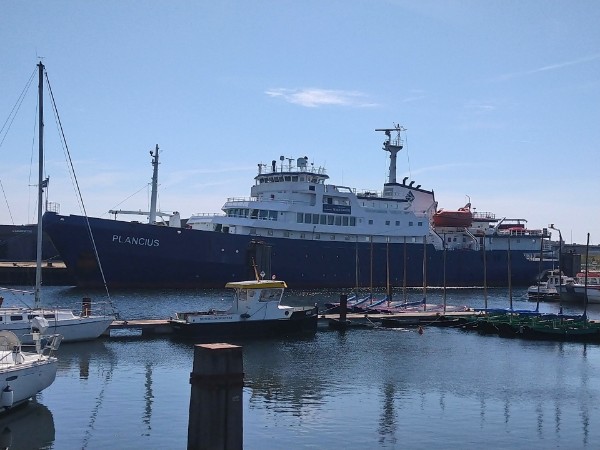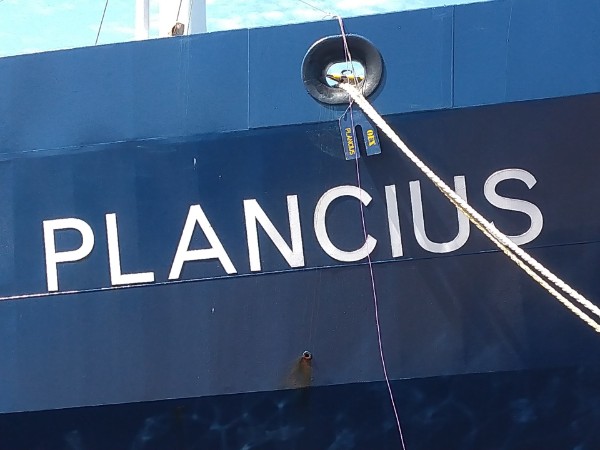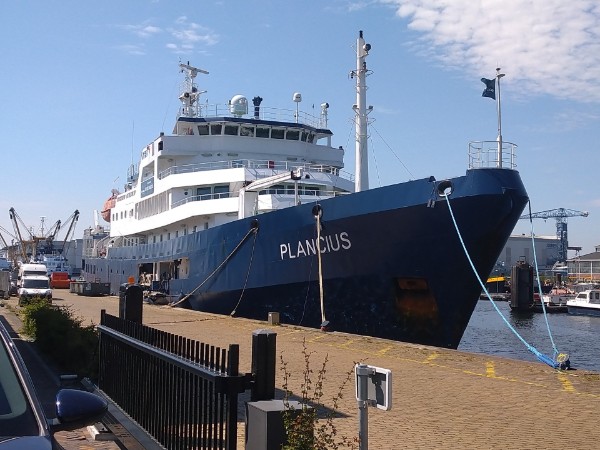Plancius
Background

Plancius as seen in the port of Vlissingen, berthed next to the companies offices. The date of the picture is the 18th of may, 2020.
Oceanwide Expeditions was founded as a successor to a former project started up by the University of Groningen in the north of The Netherlands in 1979. For this project, the University had bought a ship and had her renamed Plancius. The research program undertaken with this ship was focussed on the Dutch whaling industry around the islands of Svalbard near Norway, where the Dutch used to have a whaling colony under the name of Smeerenburg (Blubber Town in English) in the 1600's. In 1983, to gain more capital, the University also used the ship for yearly expedition cruises to the region of Svalbard, being the first 'company' in the world to offer such voyages on a yearly basis. It wasn't enough as in 1996, the University had to sell the ship because of financial difficulties and the expedition cruises thus also ended. Meanwhile, in the town of Vlissingen another company was formed in 1993 under the name of oceanwide Expeditions to sail voyages around Svalbard from 1994 onwards. For this, they had chartered a small schooner under the name of Remberandt van Rijn. When they were able to aquire a larger ship in 2004, the former naval ship Hr Ms Tydeman, this ship was renamed Plancius again in keeping the legacy of the project by the University of Groningen alive.
Construction and general statistics
The ship was built at the NV Scheepswerf & Machinefabriek De Merwede in Hardinxveld Giessendam in The Netherlands under the name Hr Ms Tydeman (A906) for the Dutch navy as yardnumber 612 and her keel was laid at the 19th of april in 1975. At the time of her launch at the 18th of december 1975, the ship measured 90,13 meters in lenght and had a tonnage of 2977. Her servicespeed for the navy was around 15 knots. Originally crewed by 59 persons although it was possible to take 15 more aboard. She was put into service at the 10th of november in 1976, starting her researchvoyages from the year 1977 onwards.
Plancius now measures 89 meters in lenght, is 14,5 meters wide and has a draft of 4,80 meters. Her tonnage measurement as a passengership is 3211 and she has space aboard for 116 passengers in 53 cabins next to 37 crewmembers, 8 expeditionstaff members and 1 doctor. From the Arctic season in 2020 onwards, the accomodations will be limited to 108 passengers. She is powered by three diesel-electric engines giving her s normal service speed of a modest 10,5 knots. She flies the Dutch flag and is homeported in Vlissingen.

Design
As this ship wasn't designed as a passengership in 1976, I will concentrate here on the design and style of the ship from 2009 onwards, although of course several features were already there at that time. Although from the late 2010's onwards expedition-cruising and small-ship ultra luxury cruising had grown closer together, Plancius is still a true expeditionship so she is not a luxury vessel. That said, she is very comfortable for her 116 passengers and they are probably choosing this ship just for that particular reason. The focus on this ship really lies in exploration and so the spaces aboard are more-over very functional and practical. The decor mostly is done as if you were in a comfortable Dutch home and the feel aboard is really very homy indeed. On deck 3 there is the restaurant which doubles as a lecture room. The space has large picture windows on the starboard and port sides of the ship so you do not have to miss the outside while dining. The restaurant can seat every passenger and staff so there is no rushing through diner to make room for a second shift and all meals aboard will be inclusive. On deck 5 the ship has a lounge/ observationroom with a bar, again with large picture windows giving good views over the surroundings of the ship. Here, there is a 24 hour service for hot and cold drinks and the bar is well stocked with a number of beverages you would expect in a good bar. Many comfortable loungechairs are places close-by the windows so you do not have to miss anything going on outside. Also there is a wraparound promenade deck on deck 3 and ample outside space for all passengers to enjoy the life outside.
Not to be missed of course is her extensive library, filled with many books about the Arctic, wildlife and history, gology and geography. Also, there are many nautical maps to study but if you just want to search for a novel or light reading that is also possible here.

As she was built as an oceanographic researchvessel for the Dutch navy, the ship has an ice-strenghtened hull and of course that is something very usefull in her new role as an exploration cruiseship. She is strongly built with a strenghtened bow and stern and is classified as an ice-class 1D. She was designed with a special six-bladed propeller, something that really makes her a silent ship.
All cabins are designed for longer voyages in colder climate and are very comfortable. All have twin or double lower beds, ample storage-space, a writingdesk and a flatscreen TV and of course all cabins have their private facilities with included soap, shampoo and moisturizer. All cabins also have outside views through classic portholes or on the higher decks windows.
The ship is equipped with ten Zodiac crafts used for exploration and two gangways on the starboard side of the ship provide easy access to those while the ship is berthed or anchored.
Carreer as Hr Ms Tydeman
Hr Ms Tydeman was named after Gustaaf Frederik Tydeman (1858-1939) who had been the commander of Hr Ms Siboga during the Siboga expedition in the years 1899 and 1900. This was an expedition to study the marine flora and fauna in the Dutch Indies (now Indonesia). As said, the Hr Ms Tydeman started her naval services in 1977 as an oceanographic researchvessel, build for militairy/ hydrographic as well as civilian researchprojects. It was decided that the ship was to be used for civilian research around 30% of her sailingtime, and as she was employed around 130 to 190 days a year, this meant that this was around 50 days a year. She was also used every year to visit foreign ports for publicity and in her first year she visited Monaco for the 11th International Hydrographic Convention. Also in 1998 she visited Lisbon for the World Fair 'The Future Of The Oceans'.
She was employed for many projects during her lifetime, mostly spread out over many years like the CANCAP project that was undertaken around the Canary Islands and Cape Verde between 1977 and 1987 and research for plancton in the Atlantic in 1980/ 1982 and 1983.
In 2004, the ship was taken out of service for the Dutch navy and it was meant for her to be sold to the Nigerian navy. But as the Nigerians failed to pay for the ship, she instead was sold for 900.000 Euro to the new Dutch expeditioncruise company Oceanwide Expeditions in 2007, based from Vlissingen. For this, the ship had to rebuild extensively for her future use as a passengership.

Plancius
The rebuilding of the ship took place at the Reimerswaal Shipyard at Hansweert, The Netherlands and she was largely rebuild with an extended superstructure both forward and aft. Also on the ships aft decks, new deckhouses were constructed. Very recognizable still is her funnel ,that wasn't changed visibly from her time in the Dutch navy. Of course her interiours were totally stripped and rebuild. She was named for Petrus Plancius (1552-1622) who was a Flemish cartographer, astronomer and preacher. Also the name is a tribute to Oceanwide Expeditions' predesessor, as the company was founded to continue the work of the Plancius Foundation.
Plancius entered service for Oceanwide Expeditions in 2009 and mostly sails Arctic and Antarctic expeditions.

